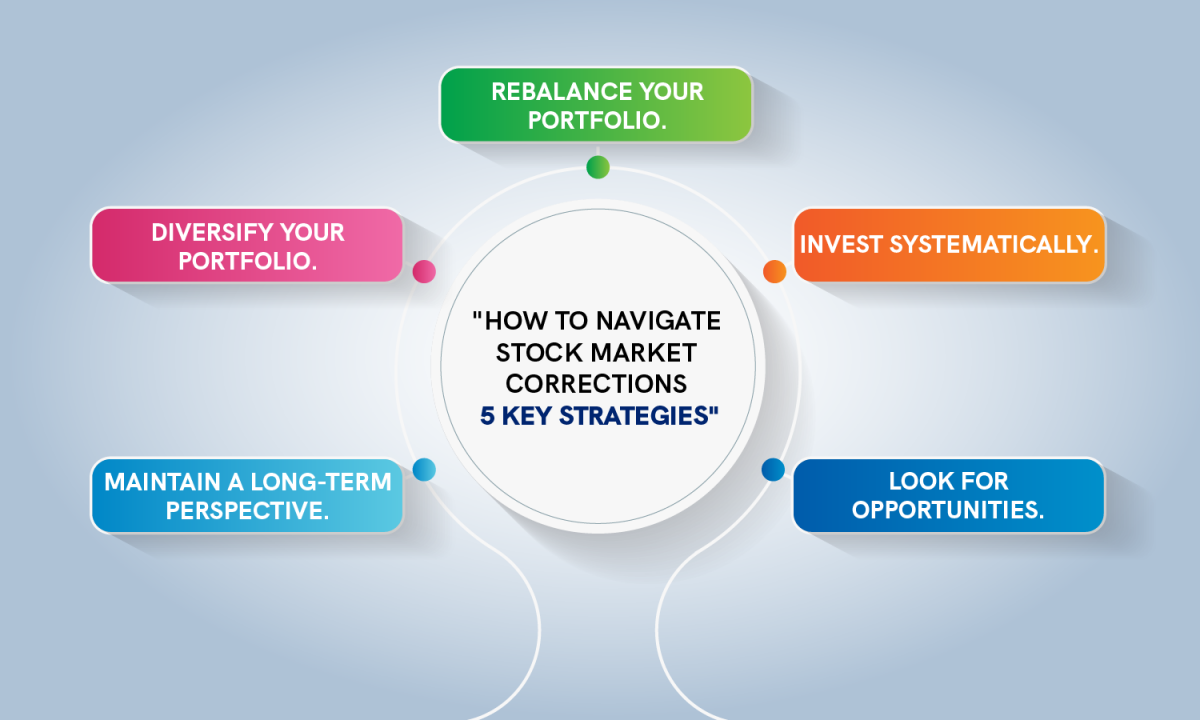Stock Market Correction: Factors, Causes & How to Identify


00:00 / 00:00
In 2008, Rakesh, a small-time retail investor from Mumbai, was left dumbfounded when the Indian stock market tumbled rapidly, erasing a significant portion of his investments.
He, along with countless other investors, had just experienced what is a stock market correction, an event that changed the course of their financial journeys.
While these corrections can be unsettling, understanding them can help investors navigate the complex world of stock market investing.
Stock market corrections are a common occurrence in the financial world, and every investor must be aware of their potential impact.
This article aims to provide an in-depth understanding of stock market correction meaning, its key factors, and how they differ from crashes and bear markets.
What is a Stock Market Correction? Definition and Key Factors
A stock market correction is a temporary decline in the overall stock market or a specific index, usually by at least 10% from its recent peak.
This decline represents a short-term setback in a longer-term upward trend. Corrections are often fueled by investors’ collective decision to take profits, re-evaluate market conditions, or react to external events.
Key factors that contribute to a stock market correction include:
Overvaluation:
When stock prices rise too quickly or do not match from the companies’ underlying fundamentals, a correction can bring them back in line with their actual value.
For example, during the dot-com bubble of the late 1990s, many tech stocks had significantly inflated valuations, which ultimately led to a market correction in the early 2000s.
Market sentiment:
A sudden shift in investor sentiment from optimism to pessimism can lead to a correction.
In 2018, concerns over the US-China trade war escalated, causing investor sentiment to sour, and resulted in a global stock market correction.
Socio-economic factors:
Unforeseen economic developments or changes in government policies can also trigger a correction.
For instance, in 2016, the Indian government’s decision to demonetize high-value currency notes led to a temporary decline in the stock market.
Similarly, socio-political events like a war, natural disasters, political upheavals or Black Swan event like Covid-19 can un-nerve the market sentiment.
Difference between Stock Market Correction, Crash, and Bear Market

Understanding the distinctions between what is stock market correction, crashes, and bear markets is crucial for investors. Here are the main differences:
Stock Market Correction:
As mentioned earlier, a correction is a short-term decline of at least 10% from the recent peak.
It typically lasts for a few weeks to a few months and is considered a normal part of market cycles.
Stock Market Crash:
A crash is a sudden and sharp drop in stock prices, usually by more than 20%.
Crashes often occur within a short period, such as a day or a week, and are usually triggered by panic selling, economic crises, or unexpected events.
The 2008 financial crisis is an example of a stock market crash that had severe consequences for the global economy.
Bear Market:
A bear market is a prolonged period of declining stock prices, typically lasting at least several months and characterized by a drop of 20% or more from the market’s peak.
Bear markets are often accompanied by negative investor sentiment, economic slowdowns, and reduced corporate profits.
The Indian stock market experienced a bear market from January 2008 to March 2009, with the BSE Sensex declining by around 60% during that period.
Historical Stock Market Corrections in India
India has experienced several lists of stock market corrections over the years. Here are some notable examples:
The Harshad Mehta Scam (1992):
The stock market experienced a massive correction after the exposure of the Harshad Mehta scam.
The BSE Sensex fell by around 40% in just two months, from April to June 1992. It is one of the biggest stock market correction India.
The Dot-com Bubble Burst (2000):
Indian stock markets were not immune to the global dot-com bubble burst.
The BSE Sensex dropped by approximately 56% from its peak in February 2000 to its low in September 2001.
The Global Financial Crisis (2008):
The Indian stock market witnessed a significant correction during the global financial crisis.
The BSE Sensex plunged by over 60% between January 2008 and March 2009.
Demonetization (2016):
The unexpected demonetization of high-value currency notes by the Indian government led to a short-term correction.
The BSE Sensex declined by around 6% within a month after the announcement.
Covid-19 Pandemic (2020):
Covid-19 hit in Jan 2020 and shocked the world. 23rd March saw the Sensex crashing 13% with lockdown announcement and spiraled down for many days.
Sensex went from 42,273 to 28,288 in one week.
Table: Major Stock Market Corrections in India
Year |
Event |
BSE Sensex Decline |
1992 |
Harshad Mehta Scam |
~40% |
2000-2001 |
Dot-com Bubble Burst |
~56% |
2008-2009 |
Global Financial Crisis |
~60% |
2016 |
Demonetization |
~6% |
2020 |
Covid 19 Pandemic |
~33% |
What Causes a Stock Market Correction?
Stock market corrections can be attributed to a variety of factors. Some common causes include:
- Economic data: Disappointing economic data, such as weak GDP growth, high inflation, or rising unemployment, can lead to market corrections.
- Political events: Elections, changes in government policies, or geopolitical tensions can result in stock market corrections as investors reassess their expectations.
- Interest rates: Central banks’ monetary policy decisions, especially changes in interest rates, can impact the stock market. A hike in interest rates might trigger a market correction, as borrowing costs increase and corporate profits are affected.
- Global factors: International events, such as economic crises or trade wars, can also impact the Indian stock market, leading to corrections.
- Black Swan Events: Unexpected events like the COVID pandemic in 2020 that hit the entire world and global economy, can trigger sudden market meltdowns.
How to Identify Stock Market Correction Indicators
While predicting the exact timing of a stock market correction is challenging, investors can look for certain indicators that suggest an increased likelihood of a correction:
- Market valuation: When market indices, such as the BSE Sensex or Nifty 50, are trading at significantly high price-to-earnings (P/E) ratios compared to their historical averages, it might indicate that a correction is due.
- Market sentiment: Excessive optimism or pessimism among investors can be a sign of an impending correction. Investors can look for indicators like the put-call ratio or the volatility index (VIX) to gauge market sentiment.
- Economic indicators: Keeping an eye on economic data, such as GDP growth, inflation, and unemployment rates, can help investors identify potential market corrections.
- Technical analysis: Investors can use technical analysis tools, such as moving averages, trendlines, and support and resistance levels, to spot potential reversals in the stock market.
Strategies for Investors During Stock Market Corrections
Investors can adopt several strategies to navigate stock market corrections effectively:

Maintain a long-term perspective: It is essential to remember that corrections are temporary setbacks in the broader market trend.
Investors should focus on their long-term financial goals and avoid making hasty decisions based on short-term market fluctuations.
Diversify your portfolio: Diversification helps mitigate risks by spreading investments across various asset classes, sectors, and geographies.
This approach can help reduce the impact of a market correction on your overall portfolio.
Rebalance your portfolio: Regularly rebalancing your portfolio ensures that your asset allocation remains in line with your risk tolerance and investment objectives.
During market corrections, this may involve selling overvalued assets and investing in undervalued ones.
Invest systematically: Systematic investment plans (SIPs) allow investors to invest a fixed amount regularly, irrespective of market conditions.
This approach helps average out the cost of investments over time, reducing the impact of market corrections.
Look for opportunities: Market corrections can present excellent buying opportunities for long-term investors.
For example, during the 2008 financial crisis, many quality stocks were available at attractive valuations, and investors who capitalized on this opportunity have seen significant gains since then.
Open a demat account with Rupeezy, invest in equity, IPO, F&O, commodities and currencies.
Long-term Impact of Stock Market Corrections
While stock market corrections can be unnerving, it is important to recognize their long-term impact. Here are some key points to consider:
- Corrections are a part of market cycles: Historically, market corrections have been followed by recovery and expansion phases. Investors who maintain a long-term perspective can benefit from the eventual rebound in stock prices.
- Corrections create opportunities: As mentioned earlier, corrections can offer attractive entry points for quality stocks. Investors who capitalize on these opportunities can potentially achieve higher returns in the long run.
- Long-term market trends remain positive: Despite short-term corrections, the Indian stock market has demonstrated a strong long-term upward trend. For example, the BSE Sensex has grown from around 4,000 points in 2000 to over 60,000 points in 2021.
Conclusion: Embracing Volatility and Staying Informed
Stock market corrections are an inevitable part of investing. By understanding the nature of corrections and adopting effective strategies, investors can better navigate these challenging periods.
Embracing market volatility and staying informed about the factors that drive corrections can help investors make well-informed decisions and achieve their long-term financial goals.
Remember, patience and discipline are essential for success in the world of stock market investing. Visit our blogpage for more such interesting articles.
Key Takeaways
- A stock market correction is a temporary decline of at least 10% from a recent peak, often caused by factors such as overvaluation, market sentiment shifts, and economic developments.
- Corrections are different from stock market crashes, which involve a sudden and sharp drop of more than 20%, and bear markets, which are prolonged periods of declining stock prices.
- India has experienced several notable stock market corrections, including the Harshad Mehta Scam (1992), the Dot-com Bubble Burst (2000), the Global Financial Crisis (2008), and Demonetization (2016).
- Investors can navigate stock market corrections by maintaining a long-term perspective, diversifying their portfolios, rebalancing their investments, and looking for opportunities.
- Despite short-term setbacks, the long-term impact of stock market corrections is often positive, with market trends remaining upward and corrections creating investment opportunities.
FAQs
How long do market corrections usually last?
The duration of market corrections can vary, generally lasting anywhere from several weeks to a few months.
The length depends on factors such as the depth of the decline, investor sentiment, and the state of the economy.
What term is used to describe a 20% correction?
When stock prices experience a decline of 20% or more, it is typically referred to as a bear market. These markets are characterized by extended periods of falling stock prices and negative investor sentiment.
Are stock market corrections considered positive?
In the long run, stock market corrections can be advantageous, as they help reestablish equilibrium and realign stock prices with their true value.
They also provide long-term investors with the opportunity to invest in high-quality stocks at attractive prices.
Is the market expected to recover after a correction?
Historically, stock markets have recovered from corrections and resumed their upward trajectory.
While the timing of the recovery may vary, long-term investors can benefit from the eventual rebound in stock prices.
What distinguishes a stock market crash from a correction?
A stock market crash involves a rapid and substantial drop in stock prices, usually over 20%, often driven by panic selling or economic crises.
In contrast, a stock market correction is a temporary decline of at least 10% from a recent peak, considered a normal aspect of market cycles.
What occurs during a stock market correction?
During a stock market correction, stock prices fall as investors take profits, reevaluate market conditions, or respond to external events.
While corrections can lead to short-term losses for investors, they also create opportunities to invest in quality stocks at lower prices.
The content on this blog is for educational purposes only and should not be considered investment advice. While we strive for accuracy, some information may contain errors or delays in updates.
Mentions of stocks or investment products are solely for informational purposes and do not constitute recommendations. Investors should conduct their own research before making any decisions.
Investing in financial markets are subject to market risks, and past performance does not guarantee future results. It is advisable to consult a qualified financial professional, review official documents, and verify information independently before making investment decisions.
Open Rupeezy account now. It is free and 100% secure.
Start Stock InvestmentAll Category









